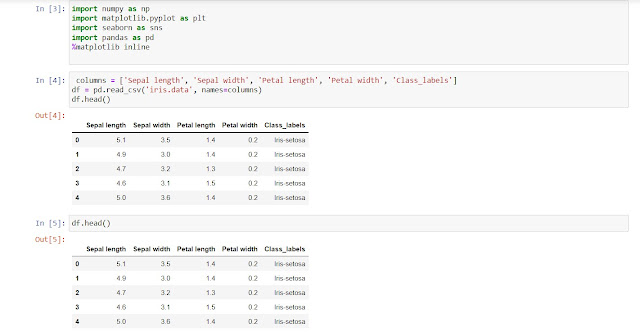Iris Flower Classification
Iris Flower Classification Project using Machine Learning
What is machine learning?
Categories of Machine Learning :
Applications of Machine Learning:
2. Recommendation Engine: Using the past behavior of a human’s search data the recommendation engine can produce new data to cross-sell products to customers. For example – Amazon product recommendations, Spotify music recommendations.
3. Chatbot: Chatbots are used to give customer services without any human agent. It takes questions from users and based on the question it gives an answer as a response.
In this project, we’ll solve the problem using a supervised learning approach. We’ll use an algorithm called “Support vector machine”.
Support vector machine: A support vector machine (also known as a support vector network) is a supervised machine learning algorithm that analyzes data for classification and regression. SVMs are one of the most robust classifications methods.
SVM approximates a separate line (Hyperplane) between two classes.
SVM algorithm finds the points closest to the line from both classes. These points are known as support vectors. Then it computes the distance between the line and support vectors. This distance is called the margin. The main goal is to maximize the margin. The hyperplane which has the maximum margin is known as the optimal hyperplane.
SVM mainly supports binary classification natively. For multiclass classification, It separates the data for binary classification and utilizes the same principle by breaking down multi-classification problems into multiple binary classification problems.
Prerequisites:
1. Numpy- 1.19.3
2. Matplotlib- 3.3.2
3. Seaborn – 0.11.1
4. Pandas – 1.2.4
5. Scikit-learn – 0.24.2
Download Iris Flower Classificatio ProjectCode
Steps to Classify Iris Flower:
3. Model training.
4. Model Evaluation.
5. Testing the model.
Step 1 – Load the data:
First, we’ve imported some necessary packages for the project.
- Numpy will be used for any computational operations.
- We’ll use Matplotlib and seaborn for data visualization.
- Pandas help to load data from various sources like local storage, database, excel file, CSV file, etc.
- Next, we load the data using pd.read_csv() and set the column name as per the iris data information.
- Pd.read_csv reads CSV files. CSV stands for comma separated value.
- df.head() only shows the first 5 rows from the data set table.
- All the numerical values are in centimeters.
Step 2 – Analyze and visualize the dataset:
Let’s see some information about the dataset.
From this description, we can see all the descriptions about the data, like average length and width, minimum value, maximum value, the 25%, 50%, and 75% distribution value, etc.
- From this visualization, we can tell that iris-setosa is well separated from the other two flowers.
- And iris virginica is the longest flower and iris setosa is the shortest.
- Here we separated the features from the target value.
- Np.average calculates the average from an array.
- Here we used two for loops inside a list. This is known as list comprehension.
- List comprehension helps to reduce the number of lines of code.
- The Y_Data is a 1D array, but we have 4 features for every 3 classes. So we reshaped Y_Data to a (4, 3) shaped array.
- Then we change the axis of the reshaped matrix.
- We used matplotlib to show the averages in a bar plot.
- Here we can clearly see the verginica is the longest and setosa is the shortest flower.
Step 3 – Model training:
- Using train_test_split we split the whole data into training and testing datasets. Later we’ll use the testing dataset to check the accuracy of the model.
- Here we imported a support vector classifier from the scikit-learn support vector machine.
- Then, we created an object and named it svn.
- After that, we feed the training dataset into the algorithm by using the svn.fit() method.
Step 4 – Model Evaluation:
- Now we predict the classes from the test dataset using our trained model.
- Then we check the accuracy score of the predicted classes.
- accuracy_score() takes true values and predicted values and returns the percentage of accuracy.
Output:
0.9666666666666667
The accuracy is above 96%.
- The classification report gives a detailed report of the prediction.
- Precision defines the ratio of true positives to the sum of true positive and false positives.
- Recall defines the ratio of true positive to the sum of true positive and false negative.
- F1-score is the mean of precision and recall value.
- Support is the number of actual occurrences of the class in the specified dataset.
Step 5 – Testing the model:
- Here we take some random values based on the average plot to see if the model can predict accurately.
Output:
Prediction of Species: [‘Iris-setosa’ ‘Iris-versicolor’ ‘Iris-virginica’]
It looks like the model is predicting correctly because the setosa is shortest and virginica is the longest and versicolor is in between these two.
- We can save the model using pickle format.
- And again we can load the model in any other program using pickle and use it using model.predict to predict the iris data.
Summary:
In this project, we learned to train our own supervised machine learning model using Iris Flower Classification Project with Machine Learning. Through this project, we learned about machine learning, data analysis, data visualization, model creation, etc.
project code :project code
JUPYTER NOTEBOOK: Notebook




.jpg)
.jpg)
.jpg)



Comments
Post a Comment